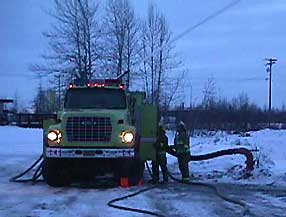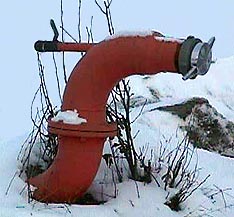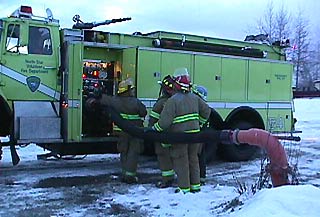|
|
| The North Star Dry Hydrant |

|
| Photo © 2001 North Star Volunteer Fire Department |
|
To keep their dry hydrants serviceable, in late autumn of each year, a high volume, low pressure air source is used to "blow down" the water level in the supply pipe to below the freeze line; the hydrant is then sealed making it essentially freeze-proof. In the words of Jerry Hanson, Deputy Chief, Operations Division at North Star, "We have successfully drafted from these hydrants at -40 to -50 degrees F. ambient temperatures. During use, the drafting engine keeps moving water to keep the draft and to avoid freezing problems. After use, the hydrant is immediately charged with air again and the hydrant is available for use in the future." |
 |
The hydrants consist of 6 inch (152.4 cm) steel casings with one 4-1/2 inch (114.3 cm) fitting at the steamer port, and a 1-1/2 inch (38.1 cm) fitting with a 1/4 turn valve at the elbow directly behind the steamer port.
|
| Photo © 2001 North Star Volunteer Fire Department |
| The advantage of all-steel construction is greater strength, compared to PVC dry hydrants, an important consideration when connecting hard suction. |

|
| Photo © 2001 North Star Volunteer Fire Department |
|
"For the air-charge adapters, we started with a 2-1/2 inch discharge cap, drilled a hole and welded a fitting or nipple that a section of high pressure hose attaches to (sort of like a water thief). On the other end of the hose is a fitting to attach directly to an SCBA bottle. We use a 2-1/2 inch to 1-1/2 inch adapter, and a 1-1/2 inch double female to connect to the 1-1/2 inch fitting on the hydrant." The Blow Down Procedure: As Jerry relates, "We have a 2-1/2 inch discharge cap adapted to connect to an air hose fitting, that in turn connects directly to an SCBA bottle. We use a 2-1/2 inch to 1-1/2 inch adapter to fit onto the 1-1/2 inch fitting. To charge the hydrant with air, first inspect the seal on the steamer cap and seat securely (we use a rubber mallet). Connect the air charging apparatus to the 1-1/2 inch fitting, open the 1/4 turn valve, and open the SCBA bottle slowly. For hydrants in gravel pits or other bodies of water , when air is visible bubbling up from the end of the pick-up pipe, close the 1/4 turn valve, disconnect the air bottle, and the task is complete. For in-ground hydrants, we dump an entire air bottle in each hydrant, close the 1/4 turn valve, disconnect and the task is complete. It is very important to only crack the SCBA bottle a little so as not to damage an in-ground hydrant. A regulator would make this job safer. One bottle has been sufficient to push the water down every year. We do not use a pressure gage on any hydrants." "This system is very simple, and requires little to no maintenance. We recruit private property owners that have control over access to water sources, and that can maintain access to the hydrant year 'round, to do the digging, welding, and backfilling, and we provide the hydrant components and consulting advice on the installation.We have 5 in place so far, and project installing up to 6 more summer 2001." The North Star dry hydrant is viable concept for many of the world's cold regions with abundant ground water, lakes, or gravel pit sources. Dry hydrants can offer an alternative to the very high cost of installing municipal type hydrants, yet provide a reliable source of water and an insurance savings for service area residents. Thanks to the North Star Volunteer Fire Department, North Pole, Alaska, for the information and use of the photos presented on this page.
|